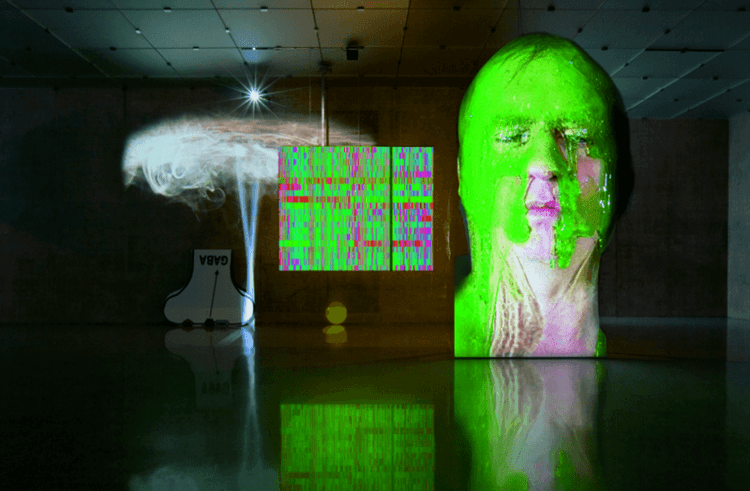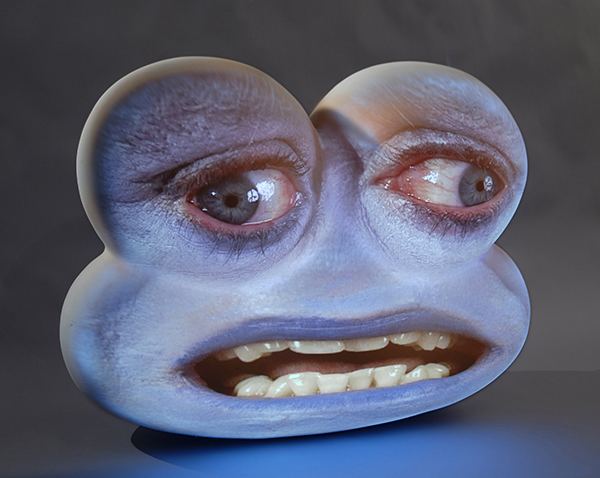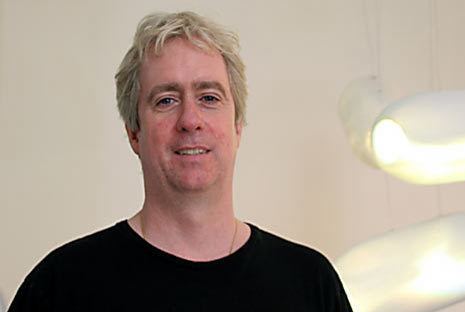Nationality American Spouse(s) Jacqueline Humphries | Name Tony Oursler Role Artist | |
 | ||
Books Poetics Project, Tony Oursler the Influence Machine Movies Aspect: The Chronicle of New Media Art: Vol. 8 Similar People Dan Graham, John Baldessari, Bill Viola, Marcel Duchamp | ||
Oursler @ AROS
Tony Oursler (born 1957) is an American multimedia and installation artist. He completed a Bachelor of Fine Arts at the California Institute for the Arts, Valencia, California in 1979. His art covers a range of mediums working with video, sculpture, installation, performance and painting. The artist currently lives and works in New York City. He is married to painter Jacqueline Humphries.
Contents
- Oursler AROS
- Tony oursler at pinchukartcentre in kyiv
- Early life and education
- Tapes Installations 1977 1989
- Projection 1991
- Public Projects 2000 2009
- 2010 exhibitions
- Collaborations
- Film and video
- Exhibitions
- Publications
- Collections
- Art market
- References

Tony oursler at pinchukartcentre in kyiv
Early life and education

Born in Manhattan in 1957, Oursler was brought up in Nyack, New York. At CalArts, his fellow students included Mike Kelley, Sue Williams, Stephen Prina and Jim Shaw. John Baldessari — with whom he did an independent study — and Laurie Anderson were teachers. Oursler moved back to New York in 1981 and was picked up by Electronic Arts Intermix.

In 1999, Oursler moved to a studio near New York City Hall.
Tapes, Installations: 1977-1989

Tony Oursler is known for his fractured-narrative handmade video tapes including The Loner (1980) and EVOL (1984). These works involve elaborate sound tracks, painted sets, stop-action animation and optical special effects created by the artist. The early videotapes have been exhibited extensively in alternative spaces and museums, they are distributed by Electronic Arts Intermix. His early installation works are immersive dark-room environments with video, sound, and language mixed with colorful constructed sculptural elements. In these projects, Oursler experimented with methods of removing the moving image from the video monitor using reflections in water, mirrors, glass and other devices. For example, L-7, L-5, exhibited at The Kitchen in 1983, used the translucent quality of video reflected on broken glass.
Projection: 1991

Oursler began working with small LCD video projectors in 1991 in his installation The Watching presented at documenta 9, featuring his first video doll and dummy. This work utilizes handmade soft cloth figures combined with expressive faces animated by video projection. Oursler then produced a series of installations that combined found objects and video projections. Judy (1993) explored the relationship between multiple personality disorder and mass media. Get Away II features a passive/aggressive projected figure wedged under a mattress that confronts the viewer with blunt direct address. These installations led to great popular and critical acclaim.
Signature works have been his talking lights, such as Streetlight (1997), his series of video sculptures of eyes with television screens reflected in the pupils, and ominous talking heads such as Composite Still Life (1999). An installation called Optics (1999) examines the polarity between dark and light in the history of the camera obscura. In his text "Time Stream", Oursler proposed that architecture and moving image installation have been forever linked by the camera obscura noting that cave dwellers observed the world as projections via peep holes. Oursler's interest in the ephemeral history of the virtual image lead to large scale public projects and permanent installations by 2000.
Public Projects: 2000-2009
The Public Art Fund and Artangel commissioned the Influence Machine in 2000. This installation marks the artist's first major outdoor project and thematically traced the development of successive communication devices from the telegraph to the personal computer as a means of speaking with the dead. Oursler used smoke, trees and buildings as projection screens in Madison Square Park NYC and Soho Square London. He then completed a number of permanent public projects in Barcelona, New Zealand, Arizona including "Braincast" at the Seattle Public Library. In 2009 he created a series of commissioned video installations at the Frank Sinatra School of the Arts in Astoria, New York.
2010 exhibitions
From October–December 2010, the Lehmann Maupin Gallery hosted Oursler's exhibition entitled Peak. The exhibition was timed with Oursler's Valley, the inaugural exhibition of the Adobe Museum of Digital Media.
Collaborations
Oursler was part of the musical and performance group, "Poetics", with fellow California Institute of the Arts students Mike Kelley and John Miller. "Mike played the drums and I sang and we both played organ — we both bonded on that probably because of our Catholic upbringing. Though to say 'played' is an exaggeration; we made noises," Oursler said in a 2012 interview on the occasion of Kelley's death.
Oursler was a longtime friend of David Bowie and collaborated with him on several works. Oursler created the background videos that played at David Bowie's 50th birthday party concert in 1997. In 2000, Oursler and Bowie collaborated on the four-minute short film Empty, in which Bowie's disembodied head provided narration. Oursler made the video to accompany Bowie's January 2013 single "Where Are We Now?", and a piece showing two Bowie heads in conversation with each other for the 2013 "David Bowie Is" exhibit organized by the Victoria and Albert Museum.
Film and video
See videos Electronic Arts Intermix
Exhibitions
Oursler's work has been exhibited in public institutions including the Walker Art Center, Minneapolis; documenta VIII, IX, Kassel; Museum of Modern Art, New York; the Centre Georges Pompidou, Paris; the D.O.P. Foundation, Caracas; the Carnegie Museum of Art, Pittsburgh; Skulptur Projekte Münster; Museum Ludwig, Cologne; the Hirshhorn Museum, Washington, DC; the Tate, Liverpool. "Introjection”, the artist’s mid-career survey, was on view from 1999 to 2001 at the Williams College Museum of Art in Massachusetts, the Contemporary Arts Museum in Houston, the Museum of Contemporary Art, Los Angeles, and the Des Moines Art Center, Iowa. In 2000, Ourlser’s installation The Darkest Color Infinitely Amplified was presented at the Whitney Museum of American Art and the Tate Modern. Oursler’s work was included in Glasstress at the 54th Venice Biennale (2011).
Publications
In 2015, Oursler published Imponderable: The Archives of Tony Oursler with the LUMA Foundation.
Collections
The Carnegie Museum of Art (Pittsburgh), Fondation Cartier pour l'Art Contemporain (Paris), the Hammer Museum (Los Angeles), the Honolulu Museum of Art, the Milwaukee Art Museum, the Modern Art Museum of Fort Worth, the Museum of Modern Art (New York City), the Tate Modern, and the Whitney Museum of American Art (New York City) are among the public collections holding work by Oursler.
Art market
Oursler is represented by:
